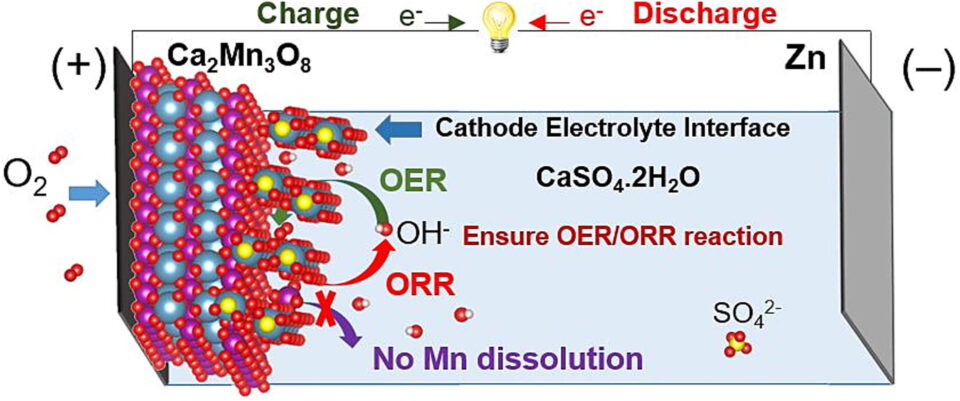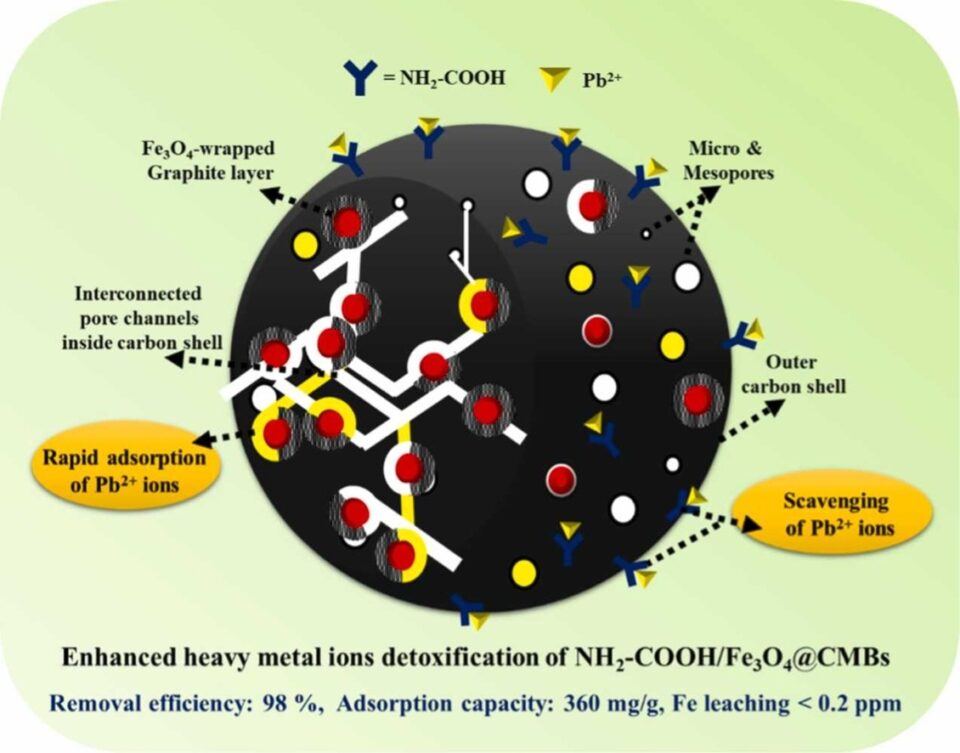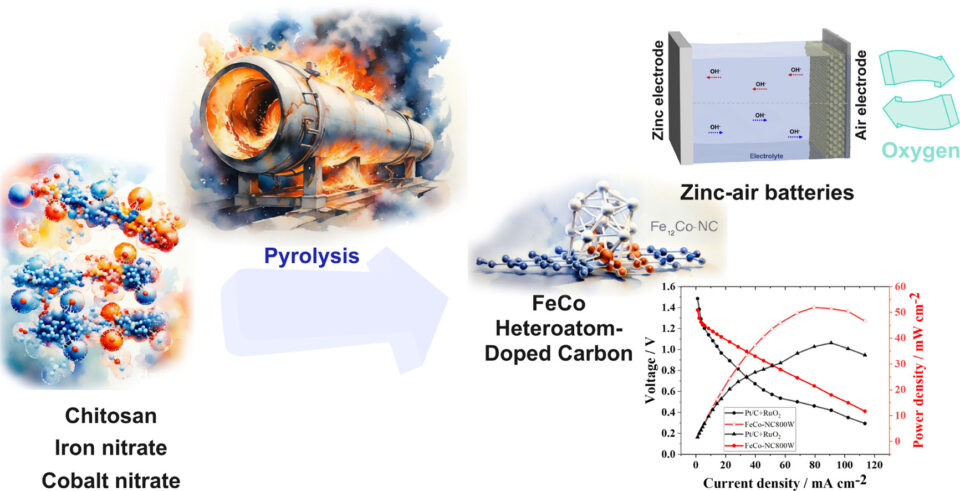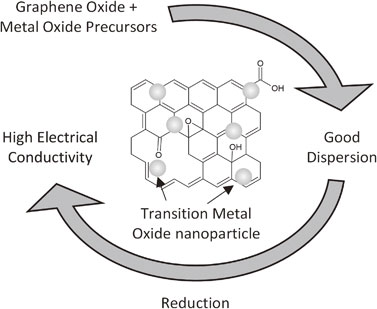名前を赤で表記しているメンバーは当研究室の学生・院生、青で表記しているメンバーは当研究室の教員です。
原著論文
- Hai Pham, Mai Thanh Nguyen, Wei Jian Sim, Te-Wei Chiu, Soorathep Kheawhom, and Tetsu Yonezawa
“In-situ Formation of Cathode Electrolyte Interphase for Suppressing Manganese Dissolution of Ca2Mn3O8 Bifunctional OER/ORR Catalyst in Stable High Current-Density Rechargeable Zinc-Air Batteries”
Applied Surface Science, 688, 162237 (2025).【Elsevier】(IF = 6.3)
DOI: 10.1016/j.apsusc.2024.162237 (Published (web) 27 December 2024)
【国際共同研究】
 Abstract: The main hurdles for Zinc–air batteries (ZABs) lie in high overpotentials of the oxygen evolution reaction (OER) and sluggish oxygen reduction reaction (ORR3). Mn-based materials have the potential as low cost and efficient OER/ORR electrocatalysts. However, Mn is prone to dissolution, causing capacity fading quickly, especially under severe battery test conditions. Our approach is to introduce a cathode-electrolyte interface (CEI), which can prevent the Mn dissolution while allowing charge carriers, OH−, and oxygen to pass for ORR/OER, ensuring continuous battery cycles. In this study, a CEI layer of CaSO4·2H2O is formed during the cycling test for Ca2Mn3O8 ORR/OER catalyst by adding SO42− to the alkaline electrolyte for the first time. The size of the opening channel of the CEI layer is enough for OH− and oxygen to pass while smaller than the soluble MnO4− formed during charging, effectively protecting the active catalyst from losing Mn. The catalyst enables ZABs with 100 % discharge capacity for 400 cycles (800 h) at 10 mA⋅cm−2. Under severe test conditions of 100 mA⋅cm−2 and 1 h charge/1h discharge per cycle, the ZABs could maintain 80 % discharge capacity for 77 cycles (154 h). The batteries with the same catalyst could resume performance for 100 cycles if the corroded gas diffusion layer was replaced. We demonstrate that the stable performance of our ZABs comes from the CEI protective layer. Furthermore, our results provide an insight into the development of low cost and stable rechargeable Zinc–air batteries under high current densities.
Abstract: The main hurdles for Zinc–air batteries (ZABs) lie in high overpotentials of the oxygen evolution reaction (OER) and sluggish oxygen reduction reaction (ORR3). Mn-based materials have the potential as low cost and efficient OER/ORR electrocatalysts. However, Mn is prone to dissolution, causing capacity fading quickly, especially under severe battery test conditions. Our approach is to introduce a cathode-electrolyte interface (CEI), which can prevent the Mn dissolution while allowing charge carriers, OH−, and oxygen to pass for ORR/OER, ensuring continuous battery cycles. In this study, a CEI layer of CaSO4·2H2O is formed during the cycling test for Ca2Mn3O8 ORR/OER catalyst by adding SO42− to the alkaline electrolyte for the first time. The size of the opening channel of the CEI layer is enough for OH− and oxygen to pass while smaller than the soluble MnO4− formed during charging, effectively protecting the active catalyst from losing Mn. The catalyst enables ZABs with 100 % discharge capacity for 400 cycles (800 h) at 10 mA⋅cm−2. Under severe test conditions of 100 mA⋅cm−2 and 1 h charge/1h discharge per cycle, the ZABs could maintain 80 % discharge capacity for 77 cycles (154 h). The batteries with the same catalyst could resume performance for 100 cycles if the corroded gas diffusion layer was replaced. We demonstrate that the stable performance of our ZABs comes from the CEI protective layer. Furthermore, our results provide an insight into the development of low cost and stable rechargeable Zinc–air batteries under high current densities. - Thirumoorthy Kulandaivel, Mohan Gopalakrishnan, Wanwisa Limphirat, Chanon Pornrungroj, Wei-Ren Liu, Ahmad Azmin Mohamad, Mai Thanh Nguyen, Tetsu Yonezawa, Soorathep Kheawhom
“Hybrid g-C3N4/sulfur-enclosed MnS micro/nanorods accelerate electron-ion transport and asymmetric supercapacitor performance”
Journal of Alloys and Compounds, 1010, 178268 (2024).【Elsevier】(IF = 5.8)
DOI: 10.1016/j.jallcom.2024.178268 (Published (web) 24 December 2024)
【国際共同研究】Abstract: Due to their potential electrochemical features, including high theoretical capacitance, environmental friendliness, and cost-effectiveness, manganese sulfide (MnS) based supercapacitors (SCs) have sparked interest. However, to optimize their performance and commercial viability, such as limited cycling stability, low electrical conductivity, aggregation of nanostructures, dissolution in electrolytes, scaling up, and high cost, several challenges need to be addressed. This study explores hybrid architecture and innovative design strategies to enhance energy density and performance of SCs while maintaining their inherent advantages. Results demonstrate that the g-C3N4/sulfur@MnS electrode reached a high specific capacitance of 493 F/g at 0.5 A/g. The full device, combining g-C3N4/sulfur@MnS with activated carbon, achieves an energy density of 18.7 Wh/kg, a power density of 327 W/kg, and maintains 81% capacitance retention after 5000 cycles. These exceptional electrochemical properties arise from the enhanced surface area, optimized pore volume, and robust redox activity of the hybrid system. Our findings position the g-C3N4/sulfur@MnS system as a leading candidate for next-generation SCs, combining high performance with long-term stability.
- Yu-Tong Huang, Dhanapal Vasu, Yung-Chieh Liu, Arjunan Dhivya Parameswari, Moorthi Pichumani, Tetsu Yonezawa, Hongbing Jia, and Te-Wei Chiu
“Enhanced remediation of textile dyes via nonmetal-modified layered graphitic carbon nitride: Influence of various oxygen precursors”
Process Safety and Environmental Protection, 192, 1420-1430 (2024). 【Elsevier】(IF = 6.9)
DOI: 10.1016/j.psep.2024.11.020 (Published (web) on 5 November 2024)
【国際共同研究】

Abstract: Layered two-dimensional (2D) graphitic carbon nitride (gCN)) doped with nonmetals has been extensively utilized as a photo-electrocatalyst. Herein, gCN doped with Oxygen was synthesized through a thermal polymerization process. The effect of various oxygen forerunners, namely citric acid (CA), oxalic acid (OX), and lactic acid (LA) on the photocatalytic ability of the gCN was analyzed. The proposed O-doped gCN samples basic characteristics were characterized by different analytical analyses. Indeed, the O-gCN has formed a sheet-like nature with a nanometre range, so often called a nanosheet. Superior photocatalytic performance was measured when the O-gCN was prepared by the CA as the O-precursor; 95 % malachite green (MG) removal was attained within a short treatment time of 40 min by adding a 20 mg photocatalyst. The influences of different parameters of catalyst concentration, different precursors, and initial pH of MG degradation were also studied. The generation of active radicals played a major part in the degradation of the MG dye solution. These findings offer fundamental insight into utilizing the O-gCN for the remediation of textile effluents in water resources. The preparation of enormous metal-free catalysts via non-metal doping toward the environmental clean-up.
- Phonnapha Tangthuam, Suttipong Wannapaiboon, Pinit Kidkhunthod, Jeng-Lung Chen, Chia-Che Chang, Chih Wen Pao, Phitchapa Ausamanwet Zijdemans, Tetsu Yonezawa, Manaswee Suttipong and Soorathep Kheawhom
Innovative pH-buffering strategies for enhanced cycling stability in zinc–iodine flow batteries
Journal of Materials Chemistry A, 12(43), 29513-29525 (2024). 【RSC】(IF = 10.7)
DOI: 10.1039/D4TA06102K (Published (web) on 8 October 2024)Abstract: Due to their high energy density, intrinsic safety, and cost-effectiveness, zinc–iodine hybrid flow batteries (ZIFBs) have gained much attention. However, challenges, such as non-uniform zinc dendrite growth and side reactions at the zinc anode limit their practical application. To address these issues, this study introduces ammonium acetate (NH4OAc) as a multifunctional additive. As such, NH4+ ions form an electrostatic shielding layer around zinc protuberances, mitigating dendrite growth. OAc− ions act as a pH buffer, maintaining an optimal pH of 5.14 at the electrode–electrolyte interface. This dual functionality improves zinc deposition and suppresses side reactions. Ex situ X-ray absorption spectroscopy (XAS) reveals that NH4+ and OAc− can modify the solvation environment of Zn2+ ions. As a result, active water molecules are reduced, enhancing the performance of the battery. These findings demonstrate that the ZIFBs with NH4OAc exhibit prolonged cycling stability, achieving up to 200 cycles at a current density of 80 mA cm−2 with an areal capacity of 20 mA h cm−2 and a coulombic efficiency (CE) of around 95%. This work highlights the potential of NH4OAc as an effective electrolyte additive for high-performing ZIFBs and similar battery systems.
- Thirumoorthy Kulandaivel, Mohan Gopalakrishnan, Sunantha Ganesan, Ahmad Azmin Mohamad, Kasidit Nootong, Mai Thanh Nguyen, Tetsu Yonezawa, and Soorathep Kheawhom
Eco-friendly synthesis and application of NH2-COOH functionalized Fe3O4@graphite carbon microballs in heavy metal removal
Journal of Environmental Chemical Engineering, 12(5), 113724 (2024). 【Elsevier】(IF = 7.4)
DOI: 10.1016/j.jece.2024.113724 (Published(web) on 31 July 2024)
【国際共同研究】

Abstract: Heavy metal pollution in wastewater is quite challenging for the environment. This study pioneers the synthesis of a novel adsorbent, amine-acid functionalized Fe3O4 decorated carbon micro-balls (NH2-COOH/Fe3O4@CMBs) via hydrothermal process and controlled thermal treatment under nitrogen atmosphere, utilizing eco-friendly resource glucose as a carbon precursor. The formation of cubic Fe3O4 nanoparticles and crystalline graphite within a carbon core-shell structure is confirmed. NH2-COOH/Fe3O4@CMBs show a porosity conducive to ion exchange in the range of 100 to 300 nm via FE-SEM, exhibiting a significant surface area of 494 m²/g with optimal pore volume. Within the carbon matrix, H2-TPR affirms the robust integration of Fe3O4, essential for high adsorption rates. In practical applications, NH2-COOH/Fe3O4@CMBs demonstrate exceptional performance, removing ~ 99% of Pb2+ ions in 30 min., showcasing an impressive adsorption capacity of 360 mg/g. The rapid and potent adsorption is attributed to the electron-rich graphite layers and the presence of abundant chelating sites. This research introduces NH2-COOH/Fe3O4@CMBs as a commercially viable and environmentally responsible solution for the removal of hazardous heavy metals from wastewater. Scientific understanding of adsorptive material not only advances but also offers a tangible approach to mitigate a pressing public health concern, marking a significant stride towards sustainable water treatment technologies.
- Mohammad Etesami, Ramin Khezri, Shiva Rezaei Motlagh, Mohan Gopalakrishnan, Poobodin Mano, Supawadee Namuangruk, Suttipong Wannapaiboon, Tetsu Yonezawa, Anongnat Somwangthanaroj, and Soorathep Kheawhom
Eco-Friendly Synthesis of Bimetallic FeCo Nanocatalysts within Heteroatom-Doped Carbon for Oxygen Reduction and Zinc-Air Battery Enhancement
Materials Today Energy, 44, 101649 (2024). 【Elsevier】(IF = 9.0)
DOI: 10.1016/j.mtener.2024.101649 (Published (web) on 20 July 2024)
【国際共同研究】

Abstract: Structural engineering emerges as a pivotal approach in crafting cost-effective and highly efficient catalysts for oxygen reduction reaction (ORR), emphasizing large surface areas, abundant reactive sites, and enhanced porosity. The incorporation of trace non-precious metals can significantly boost ORR performance through structural refinement. Here, we report on the synthesis of bimetallic FeCo nanoparticles embedded within a heteroatoms-doped carbon framework utilizing eco-friendly chitosan. This configuration yields a catalyst with marked activity for ORR in alkaline conditions, attributable to synergistic effects among Fe, Co, N, and O dopants. Comparative analysis reveals the superior performance of the FeCo-NC variant, characterized by a higher degree of defects and disorders. The standout FeCo-NC800W sample, with its 347.616 m2 g−1 surface area and pyrolysis-induced graphene coating, exhibits optimal ORR activity, closely adhering to a four-electron transfer pathway. Moreover, this catalyst demonstrates remarkable longevity and methanol resistance in ORR applications. FeCo-NC800W surpasses the conventional 20% Pt/C+RuO2 cathode in peak power density in a zinc-air battery setup, highlighting its potential as a high-performance, sustainable electrocatalyst.
- 田村一樹、西尾正樹、Mai Thanh Nguyen、米澤 徹【総説】
銅微粒子・ナノ粒子を用いた焼結性接合材料
日本金属学会誌、88(11), 270-280 (2024).
DOI: 10.2320/jinstmet.J2023042 (Published (web) 25 October 2024)
【研究室内研究】
 Abstract: Wide-bandgap power semiconductors have garnered attention for their potential use in electronic power control. For joining materials of these power semiconductors, sintering of metal nanoparticles as the bonding material has been focused. Silver nanoparticles have been extensively researched so far as these bonding materials; however, studies have shifted the focus to copper nanoparticles from the perspectives of cost and ion migration resistance. Nevertheless, copper nanoparticles are known for their low oxidation resistance, leading to a decline in sintering performance. Therefore, research has been conducted to tailor copper nanoparticle pastes to prevent their oxidation. Additionally, various techniques during the sintering process have been considered to enhance the sinter bonding. This paper introduces the paste design attempts and examples of the sintering process by using copper nanoparticle paste bonding materials.
Abstract: Wide-bandgap power semiconductors have garnered attention for their potential use in electronic power control. For joining materials of these power semiconductors, sintering of metal nanoparticles as the bonding material has been focused. Silver nanoparticles have been extensively researched so far as these bonding materials; however, studies have shifted the focus to copper nanoparticles from the perspectives of cost and ion migration resistance. Nevertheless, copper nanoparticles are known for their low oxidation resistance, leading to a decline in sintering performance. Therefore, research has been conducted to tailor copper nanoparticle pastes to prevent their oxidation. Additionally, various techniques during the sintering process have been considered to enhance the sinter bonding. This paper introduces the paste design attempts and examples of the sintering process by using copper nanoparticle paste bonding materials.
- シム ウェイジェン、グエン タンマイ、米澤 徹【総説】
貴金属フリー亜鉛空気電池用触媒
日本金属学会誌、88(8), 137-143 (2024) .
DOI: 10.2320/jinstmet.J2023039 (Published (web) 25 July 2024)
【研究室内研究】

Abstract: Zinc-Air Batteries (ZABs) are a promising solution for grid-scale torage. In this work, ZAB chemistry is reviewed and the role of catalysts at the cathode is explained. Transition metal oxides are an economical substitute for noble-metal based catalysts. However, their poor electrical conductivity requires additional efforts in catalyst activation. This is commonly done by reducing particle size and increasing electrical access which can be done simultaneously by hybridizing with carbon derivatives such as reduced graphene oxide.
(Mater. Trans., 64, 2394-2399 (2023)に掲載。)
- Sagar Ingavale, Mohan Gopalakrishnan, Phiralang Marbaniang, Woranunt Lao-atiman, Ahmad Azmin Mohamad, Mai Thanh Nguyen, Tetsu Yonezawa, Anita Swami, Soorathep Kheawhom
In-situ self-assembly of molybdenum carbide and iron carbides heterostructure on Ndoped carbon for efficient oxygen reduction reaction
Nanoscale, 16(20), 9998-10010 (2024). 【RSC】(IF = 6.7)
DOI: 10.1039/D4NR00799A (Published (web) 22 April 2024)
【国際共同研究】
Abstract: Identifying highly stable, cost-effective, platinum-free, and efficient electrocatalysts for oxygen reduction reactions (ORR) remains a formidable challenge. ORR is important for advancing fuel cell and zinc-air battery (ZAB) technologies towards cost-efficiency and environmental sustainability. This work presents the utilization of economically viable materials through a straightforward synthesis process, exhibiting the development of efficient Mo2C/Fe3C-NC catalysts, ingeniously derived from phosphomolybdic acid (PMA) and iron phthalocyanine (FePc). Results demonstrate that the optimized Mo2C/Fe3C-NC3 catalysts exhibit remarkable electrochemical performance, evidenced by an impressive onset potential of ~1.0 V versus RHE, a half-wave potential of 0.89 V, and a superior current density of about 6.2 mA cm-2. As for their performance in ZABs, the optimized catalysts reach a peak power density of 142 mW cm-2 at a current density of 200 mA cm-2. This synergy, coupled with the uniform distribution of Mo2C and Fe3C nanoparticles, greatly enhances the active catalytic sites and promotes electrolyte diffusion. Our approach diverges from traditional methods by employing an in-situ self-assembled heterostructure of Mo2C/Fe3C on nitrogen-doped carbon tubes, avoiding the conventional high-temperature hydrogen gas reduction process. Beyond serving as feasible alternatives to commercially available Pt/C catalysts, these materials hold promise for large-scale production owing to their affordability and simplicity of the synthesis technique. Such a breakthrough paves the way towards the realization of sustainable energy technologies and lays the groundwork for further exploration into amplifying the scalability and efficiency of ORR catalysts.
- Sorasak Klinyod, Nuttapon Yodsin, Mai Thanh Nguyen, Zikkawas Pasom, Sunpet Assavapanumat, Marisa Ketkaew, Pinit Kidkhunthod, Tetsu Yonezawa, Supawadee Namuangruk, Chularat Wattanakit
Unraveling the Electrocatalytic Activity in HMF Oxidation to FDCA by Fine-tuning the Degree of NiOOH Phase over Ni Nanoparticles Supported on Graphene Oxide
Small, 20(27), 2400779 (2024). 【Wiley-VCH】(IF = 13.3)
DOI: 10.1002/smll.202400779 (Published (web) 28 March 2024)
【国際共同研究】
Abstract: The development of an efficient electrocatalyst for HMF oxidation to FDCA has been in the early stages. Herein, the NiNPs/GO-Ni-foam is fabricated as an electrocatalyst for FDCA production. However, the electrocatalytic performance of the untreated NiNPs/GO-Ni-foam is observed with moderate Faradaic efficiency (FE) (73.0%) and FDCA yield (80.2%). By electrochemically treating the NiNPs/GO-Ni-foam in an alkaline solution with positive potential at different treatment durations, the degree of NiOOH on metal surfaces is changed. The distinctive electrocatalytic activity obtained when using the different NiOOH degrees allows to understand the crucial impact of NiOOH species in HMF electrooxidation. Enhancing the portion of the NiOOH phase on the electrocatalyst surface improves electrocatalytic activity in terms of FE and FDCA yield up to 94.8±4.8% and 86.9±4.1%, respectively. Interestingly, as long as the NiOOH portion on the electrocatalyst surface is preserved or regenerated, the electrocatalyst performance can be intact even after several catalytic cycles. The theoretical study via density functional theory (DFT) also agrees with the experimental observations and confirms that the NiOOH phase facilitates the electrochemical transformation of HMF to FDCA through the HMFCA pathway, and the potential limiting step of the overall reaction is the oxidation of FFCA to FDCA.
- Mai Thanh Nguyen, Pichaya Pattanasattayavong, and Tetsu Yonezawa
Detailed discussion on structure of alloy nanoparticles synthesized by magnetron sputter deposition onto liquid poly(ethylene glycol) 【Review】
Nanoscale Advances, 6(7), 1822-1836 (2024). 【RSC】【Open Access】(IF = 4.7)
DOI: 10.1039/D3NA00998J (Published (web) 1 March 2024)
【国際共同研究】

Abstract: This paper is devoted to reviewing a decade of the development of vacuum sputter deposition onto liquid poly(ethylene glycol) (PEG) to prepare metal and alloy nanoparticles (NPs) with a controlled particle growth, size, structure, and composition. Especially, we have discussed the fine structures of alloy NPs obtained in PEG and compared them with those sputtered onto other non-volatile liquids. Finally, we have shared our prospect of applications for the resulting alloy NPs.
- Yung-Chieh Liu, Dhanapal Vasu, Guan-Lin Li, Jiaxin Jiang, Te-Wei Chiu, Liangdong Fan, Zhe-lun Ye, Wei-Hsin Hu, Wei Jian Sim, and Tetsu Yonezawa
“Bi-functional CoCr2O4 hollow-sphere for enhanced oxygen evolution reaction and photocatalyst for harmful environmental pollutants removal”
Ceramics International, in press. (2024). 【Elsevier】(IF = 5.2)
DOI: 10.1016/j.ceramint.2024.03.056 (Published (web) 6 March 2024)
【国際共同研究】
Abstract: The development of a high-performance, cost-effective, and durable multifunctional semiconductor is crucial for clean energy and environmental remediation applications such as oxygen evolution reaction (OER) and photocatalysts. In this research, we have developed a hollow sphere-based spinel-structured CoCr2O4 (HS.CCO) for bi-functional applications. These hollow spheres exhibit excellent electrocatalytic OER performance under an alkaline (1 M potassium hydroxide (KOH)) medium, which displays a higher electrocatalytic ability. The spinel hollow spheres demonstrate favorable overpotentials and Tafel potentials of 180 mV and 162 mV/dec, respectively towards OER activity. On the other hand, as a photocatalysis, they portrayed outstanding degradation efficiency under visible light irradiation towards Congo red (CR) dye degradation. Within the short treatment time higher CR degradation efficiency is achieved. These photo-electroactive spinel hollow spheres accelerate efficient OER and visible-light-driven photocatalysis with remarkable stability. They serve as an excellent example of a multifunctional heterogeneous catalyst. Finally, the obtained results indicate the current needs and future demands for enhancing the prospects of multifunctional semiconductor catalysts.
- Mohan Gopalakrishnan, Wathanyu Kao-ian, Meena Rittiruam, Supareak Praserthdam, Piyasan Praserthdam, Wanwisa Limphirat, Mai Thanh Nguyen, Tetsu Yonezawa, and Soorathep Kheawhom
3D Hierarchical MOF-Derived Defect-Rich NiFe Spinel Ferrite as a Highly Efficient Electrocatalyst for Oxygen Redox Reactions in Zinc–Air Batteries
ACS Applied Materials & Interfaces, 16(9), 11537–11551 (2024). 【ACS】(IF = 9.5)
DOI: 10.1021/acsami.3c17789 (Published (web) 15 February 2024)
【国際共同研究】
Abstract: The strategy of defect engineering is increasingly recognized for its pivotal role in modulating the electronic structure, thereby significantly improving the electrocatalytic performance of materials. In this study, we present defect-enriched nickel and iron oxides as highly active and cost-effective electrocatalysts, denoted as Ni0.6Fe2.4O4@NC, derived from NiFe-based metal–organic frameworks (MOFs) for oxygen reduction reactions (ORR) and oxygen evolution reactions (OER). XANES and EXAFS confirm that the crystals have a distorted structure and metal vacancies. The cation defect-rich Ni0.6Fe2.4O4@NC electrocatalyst exhibits exceptional ORR and OER activities (ΔE = 0.68 V). Mechanistic pathways of electrochemical reactions are studied by DFT calculations. Furthermore, a rechargeable zinc–air battery (RZAB) using the Ni0.6Fe2.4O4 @NC catalyst demonstrates a peak power density of 187 mW cm–2 and remarkable long-term cycling stability. The flexible solid-state ZAB using the Ni0.6Fe2.4O4@NC catalyst exhibits a power density of 66 mW cm–2. The proposed structural design strategy allows for the rational design of electronic delocalization of cation defect-rich NiFe spinel ferrite attached to ultrathin N-doped graphitic carbon sheets in order to enhance active site availability and facilitate mass and electron transport.
書籍
- 微粒子分散・凝集講座 第3巻
「分散凝集の応用」
一般社団法人 日本ディスパージョンセンター 監修
編者:米澤 徹、武田真一、藤井秀司、石田尚之
近代科学社Digital
(2024.4.19 初版発行)
